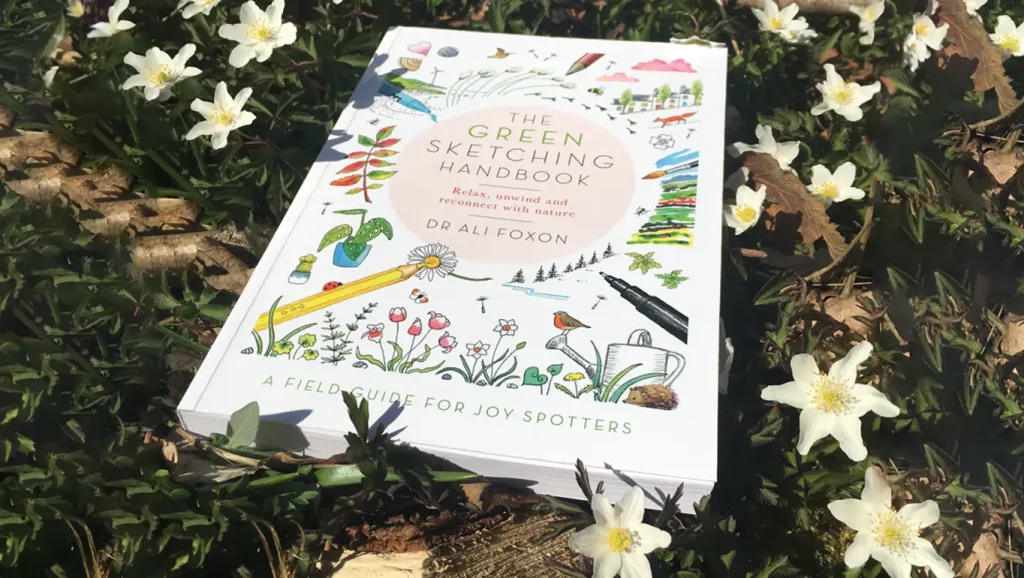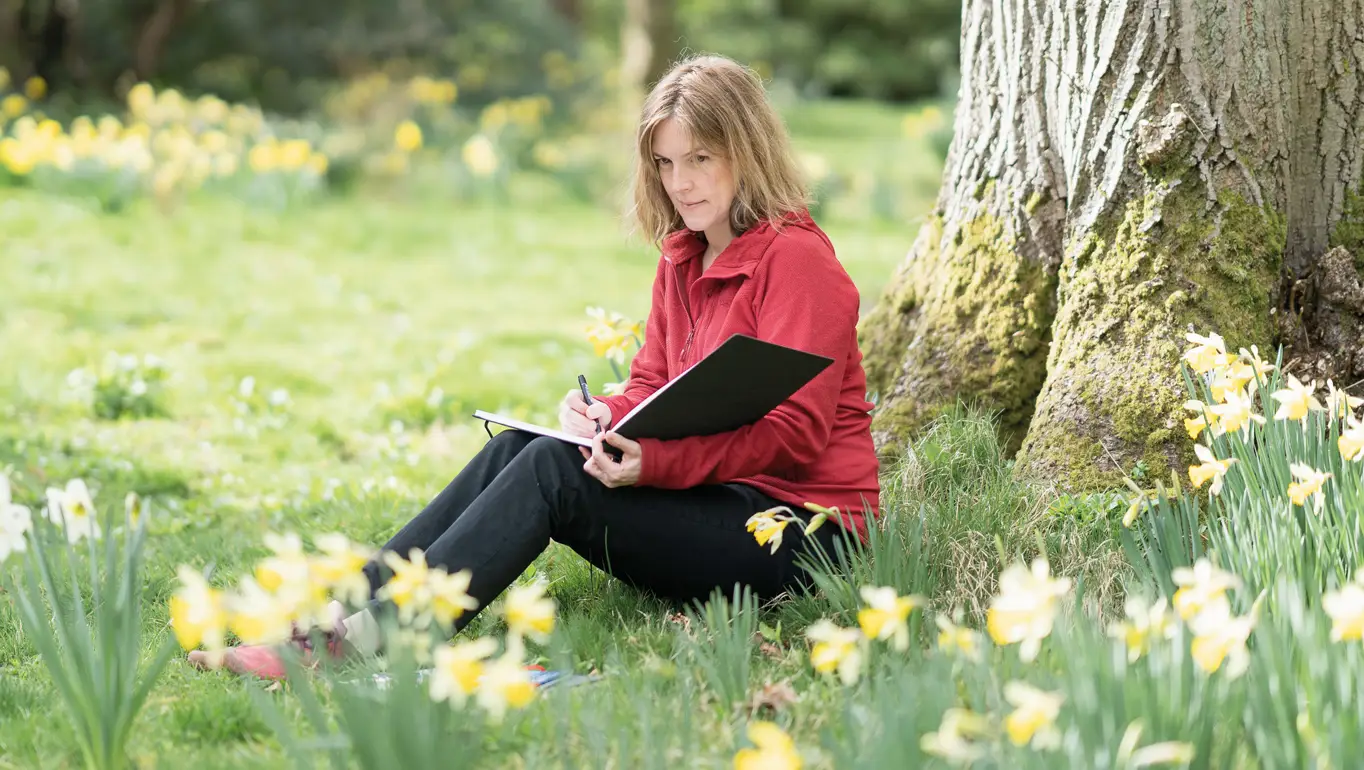Dr Ali Foxon is an artist, geographer, and founder of the green sketching movement. Her practice explores and celebrates the role of observation in our reciprocal and emotional relationship with the natural world. She is the author of The Green Sketching Handbook: Relax, Unwind and Reconnect with Nature (One Boat, 2022) and loves helping people change the way they see the world.
How did your career lead and inspire you to found the green sketching movement?
My background is in geography and the environmental sciences. I studied Scottish peat bogs, French rivers, and completed my PhD in nature conservation and climate change. As my career developed, I worked as a scientific editor and climate change advisor with a wide range of organizations, including the UK water industry, IUCN, and UNEP. The work was interesting and important, but I was spending more and more time sitting in window-less meeting rooms, staring at my laptop and working on reports that didn’t seem to change anyone’s behavior. Despite talking and writing about the environment, I was completely disconnected from nature.
Confused and (with hindsight) burned out, I took a career break soon after my son was born. We were living in Switzerland without much of a support network at the time. My baby boy only slept outdoors, so I spent many lonely hours sitting on Swiss park benches, staring at my phone. One day, bored of scrolling, I bought a little sketchbook and started sketching the world around me. I loved it! My sketches were wobbly, hesitant and often incomplete but they opened my eyes to all the beauty that was around me, beauty that had always been there, I just hadn’t seen it before.
Even better, sketching calmed my anxious brain, lifted my spirits and turned me into a joy spotter. The more I sketched, the more beauty and wonder I noticed. But I also noticed how much other people around me were missing. I became fascinated with the role observation plays in our relationship with nature and realized there was a huge opportunity to use sketching as a tool to help people reconnect with nature.
The major challenge was how to make sketching more appealing and accessible. After all, most people are convinced they can’t draw. Most people are so busy and disconnected from nature that the idea of keeping a dedicated nature journal is wildly unrealistic.
So, I developed a new approach to nature sketching called ‘green sketching’. It focuses on the process of sketching and observing, not the artwork. At the heart of green sketching is the idea that when we change what we see, we can change how we feel. The aim of green sketching is to enjoy and emotionally engage with nature’s beauty and wonder, rather than learn more about it. Although environmental education is important, when it comes to nature connection, the research is clear: we care with our hearts, not our heads.
The response to green sketching has been amazing and it’s now a movement that’s quietly spreading around the world. I’m collaborating with a range of environment organizations and training an international network of green sketching ambassadors.
Green sketching is one of the tools I use in my creative resilience programs for environmental leaders and entrepreneurs, many of whom are struggling with a growing sense of anxiety, frustration, grief, and futility. By changing their relationship with nature, creativity and themselves, I help them become happier and more resilient, so they can persevere with their crucial work.
What steps should a complete beginner take to begin nature sketching?
1. To get started, all you need is a pencil and some paper. You can experiment with a sketchbook or other materials later.
2. I recommend you start by sketching small and very simple objects, like individual leaves, tiny flowers, shells or pebbles. Tiny sketches don’t take long and are a brilliant way to build your confidence. Avoid complex or moving objects like birds, flowing water or winter trees as they can be tricky to sketch.
3. If you’re not sure what to sketch, look out for things that catch your eye and make you smile, think “Wow!” or “Huh! I never noticed that before.” This simple practice is how you train your brain to become a joy spotter.
4. Have a go at sketching the horizon, the line that separates land and sky. Look carefully and pay attention to every little bump and change in angle. It’s a simple way to calm a racing mind and treat your eyes to a restorative break from the screen. And because it’s just one line, there’s no pressure to make it look ‘good.’
5. You don’t need to share your sketches. Green sketching is a personal practice, a way of nurturing your own unique relationship with nature. Noone else needs to see your wobbly lines! Letting go of the fear of criticism (or the need for praise) is a game-changer for many people, especially recovering perfectionists.
There are many more tips about how to start green sketching in your own way, for your own well-being in my book: The Green Sketching Handbook: Relax, Unwind and Reconnect with Nature.

Do you have any memorable experiences or stories related to your green sketching?
I’ve been fortunate to sketch some incredibly beautiful places, from Swiss mountains to Canadian glaciers, Swedish forests, and Hebridean islands. Yet it’s been the everyday moments of shared wonder that have been the most rewarding part of my green sketching work. For example, when children I’ve taught tell me they now see nature in a new way, or when someone in a workshop exclaims, “Huh! I can’t believe I’m 41 and have never really looked at a nettle before!” Other people have been in touch to say green sketching has restored their creative confidence or helped them recover from Long COVID. The response has been amazing.
What is your favorite season and time of day to sketch nature and why?
The great thing about green sketching is that it’s an all-year, all-weather activity. It’s the process of sketching and observing nature that matters, not the quality of the artwork. This means it doesn’t matter if your paper tears in the wind, or your doodle smudges in the rain.
That said, I particularly love sketching in spring. I grew up in the bluebell woods in England and have always loved the abundance of blossom in April and May. I tend to sketch in a very ad hoc way, adapting what, where and how I sketch, depending on how I feel. Sometimes I pop out into the garden on a sunny morning for a quick doodle before breakfast. On other days, I just sketch the horizon out of my office window after a long Zoom call. I will often try to go for a doodle walk after work to wind down at the end of the day, especially if there are pink clouds in the sky. But there are no rules. The joy of green sketching is learning how to sketch in your own way, for your own well-being.
Do you think that nature sketching can play a role in conservation and environmental awareness?
Yes! Today we’re spending more and more time indoors, sitting down, staring at our screens. We urgently need to find ways to help as many people as possible reconnect with the natural world. This needn’t be complicated. Research has found that when we notice the everyday nature in our lives, we’re much more likely to take care of it. And one of the best ways to see something – really see it – is to try and sketch it.
Unlike taking an instant, often forgettable photo, the process of sketching slows down our vision and changes the way we see and perceive our surroundings. It opens our eyes to details, beauty and wonder we’d otherwise miss. It makes us care. Once we sketch something, whether it’s a tiny flower or mountainous horizon, we never look at it in the same way again; we know it better; we appreciate it more. The quality of our sketch is irrelevant. It’s the looking that matters and changes how we feel. And it needn’t take long. Most of my sketches only take a few minutes.
This is why green sketching has so much potential as a tool for nature connection. It’s affordable, safe, and accessible to people of all ages and abilities, in cities and rural areas. It requires no special equipment or training. We just need to encourage people to put down their phones and pick up a pencil!



